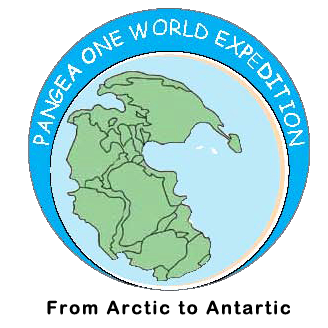
EXPEDITION ACCOUNTS
AT THE ARCTIC
For four hours we waited in the NATC shack in one corner Fairbanks airport for the fog to lift in Dead Horse. Hunters, waiting to be airlifted to their respective grounds, kept us entertained with stories of their encounters with bears, wolves, moose and caribou. Finally, our eight-seater Navajo took off in rain and flew northwards for the next two-and-a-half hours in zero visibility, the young pilot relying solely on his instruments. Besides the two of us there were two other passengers - a Swiss couple, with itchy feet, who had migrated to Australia in 1965.
Dead Horse, a 1,040-acre camp, houses the contractors working for the Prudoe Bay oil companies. The slushy site, located over the permafrost, is straight out of a science fiction movie - with massive, over-sized pick-ups, trucks, cranes, excavators, bulldozers, drills, rigs and other gigantic equipment required for oil exploration and extraction in this frozen world. Our quarters were in a container-like portable cabin with cubby-hole rooms, common showers and toilets and effective heating. The dining room, in another camper, serves appetising food and every known brand of American soda pop. The 3,000 workers that inhabit Dead Horse are all from outside and the place has no permanent residents. Working in inhospitable conditions, they earn higher, tax-free wages and are provided with boarding and lodging and free air transport to anywhere in Alaska. There is no entertainment - no movies, no restaurants, no bars - not even a church! Alcohol is prohibited as employers do not want any hungover employees handling expensive, sensitive equipment. Two weeks of work, 12 hours a day, is followed by two weeks of rest - the companies airlifting the employees to Fairbanks or Anchorage.
Watso, a security officer, half native Alaskan Indian, drove us 20 km through the eastern oilfields to the shore of the Arctic Ocean. Hearing of our journey, he quipped: "Are you guys pioneering another wave of migration from Asia to the Americas?" - referring to his Mongoloid forefathers who came, unknown thousands of years ago, in waves from East Asia, crossing the Bering Strait when it was dry land, to inhabit the Americas. The chubby officer's job for the last two years had been to keep a look-out for polar bears and alert the oil workers if there was a sighting. A lone Red Fox trotted through the tundra looking for lemmings, ground squirrels, rats, bird's nests and other fare the land had to offer.
Where the land ended, at latitude 70 degrees north, at the rim of North America, we were 500km further north of the Arctic Circle. Forty km of shallow, frigid waters separated us from the Arctic Ice Cap. During the winters even this water freezes, making it possible to walk to the North Pole. The melt begins in June. As global warming shrinks the Arctic ice cap, opening new sea passages, Arctic politics and competition between nations for claiming the Arctic resources has already begun. Though the wind was at rest it was bitterly cold. Wetting my hands in the Arctic waters made them instantly red and swollen. Doc Jain suggested we turn into 'kawad-ias' - the crazy Shiv bhakts who run amok on Indian highways, carrying water from the Ganga River at Haridwar to their village temples. Doc wants to carry some Arctic water and pour it into the Antarctic at the end of our expedition. Turning our backs on the Arctic we commenced our journey southwards.





